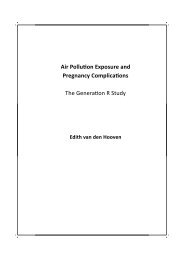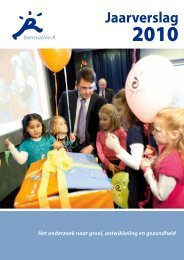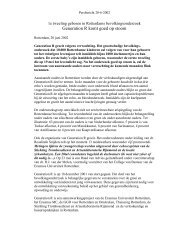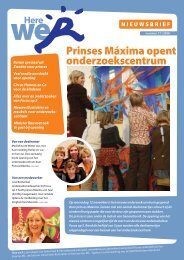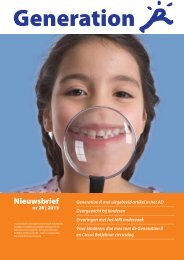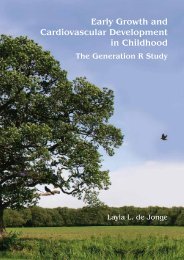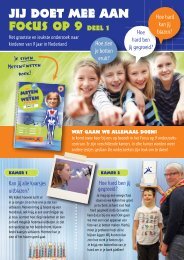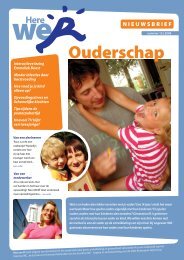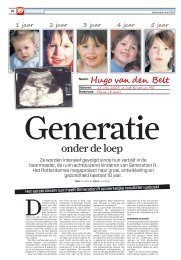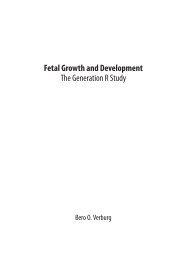Parents and infants: determinants of attachment in a ... - Generation R
Parents and infants: determinants of attachment in a ... - Generation R
Parents and infants: determinants of attachment in a ... - Generation R
You also want an ePaper? Increase the reach of your titles
YUMPU automatically turns print PDFs into web optimized ePapers that Google loves.
Chapter 1<br />
recent studies have addressed the role <strong>of</strong> biological factors such as genetics<br />
<strong>in</strong> expla<strong>in</strong><strong>in</strong>g disorganized <strong>attachment</strong> (for a review, see Bakermans-<br />
Kranenburg & Van IJzendoorn, 2007). Little is known about the neurobiology<br />
<strong>of</strong> <strong>in</strong>fant <strong>attachment</strong>. The largest study to date <strong>in</strong>vestigat<strong>in</strong>g possible<br />
(neuro-) biological antecedents such as maternal medical history, <strong>in</strong>fant<br />
anomalies at birth or neonatal behavioral orientation response, found no<br />
relation <strong>of</strong> these proxies <strong>of</strong> the child’s neuro-biological status <strong>and</strong> later<br />
<strong>attachment</strong> disorganization (Carlson, 1998; Sroufe, Egel<strong>and</strong>, Carlson, &<br />
Coll<strong>in</strong>s, 2005). However, other studies found that the behavioral orientation<br />
response <strong>of</strong> newborns predicted later <strong>attachment</strong> disorganization (Spangler,<br />
Fremmer-Bombik, & Grossmann, 1996). Also the risk <strong>of</strong> <strong>attachment</strong> disorganization<br />
was higher <strong>in</strong> <strong><strong>in</strong>fants</strong> with neuro-developmental problems, such as<br />
autism, Down’s syndrome, <strong>and</strong> neurological abnormalities due to maternal<br />
alcohol abuse dur<strong>in</strong>g pregnancy, or premature birth (for a meta-analysis see<br />
Van IJzendoorn et al., 1999). These f<strong>in</strong>d<strong>in</strong>gs suggest that neurobiological<br />
factors may be <strong>in</strong>volved <strong>in</strong> the etiology <strong>of</strong> <strong>attachment</strong> disorganization, but<br />
studies address<strong>in</strong>g the role <strong>of</strong> neurobiological differences for <strong>attachment</strong><br />
quality <strong>in</strong> human <strong><strong>in</strong>fants</strong> are scarce.<br />
The current study<br />
Attachment <strong>in</strong> <strong>Generation</strong> R<br />
Attachment <strong>in</strong>security <strong>and</strong> disorganization are risk factors for later socioemotional<br />
problems. Yet, they are frequent even <strong>in</strong> general population<br />
samples as shown by f<strong>in</strong>d<strong>in</strong>gs from the National Institute <strong>of</strong> Child Health<br />
<strong>and</strong> Human Development (NICHD) Early Child Care Research Network<br />
(ECCRN). The normative distribution derived by a meta-analysis <strong>in</strong>clud<strong>in</strong>g<br />
920 non-US Western <strong>in</strong>fant-parent dyads from the general population is:<br />
51% secure (B), 20.2% <strong>in</strong>secure-avoidant (A), 10.3% <strong>in</strong>secure-resistant <strong>and</strong><br />
18.5% disorganized (D) (Van IJzendoorn et al., 1999). However, most studies<br />
have been conducted with either high risk samples with multiple problems<br />
or relatively small convenience samples. F<strong>in</strong>d<strong>in</strong>gs from these studies may<br />
not be easily applicable to the general population <strong>and</strong> the large group <strong>of</strong><br />
families who are not at high risk nor struggl<strong>in</strong>g with cl<strong>in</strong>ical problems.<br />
In the current series <strong>of</strong> studies, we therefore exam<strong>in</strong>ed environmental<br />
<strong>and</strong> biological factors that may help expla<strong>in</strong> <strong>in</strong>dividual differences <strong>in</strong> <strong>in</strong>fant<br />
<strong>attachment</strong> quality <strong>in</strong> the general population (for an overview see Figure 1).<br />
We conducted the Strange Situation Procedure with 881 <strong>in</strong>fant-parent dyads<br />
participat<strong>in</strong>g <strong>in</strong> the <strong>Generation</strong> R Study when the child was 14 months old.<br />
16



